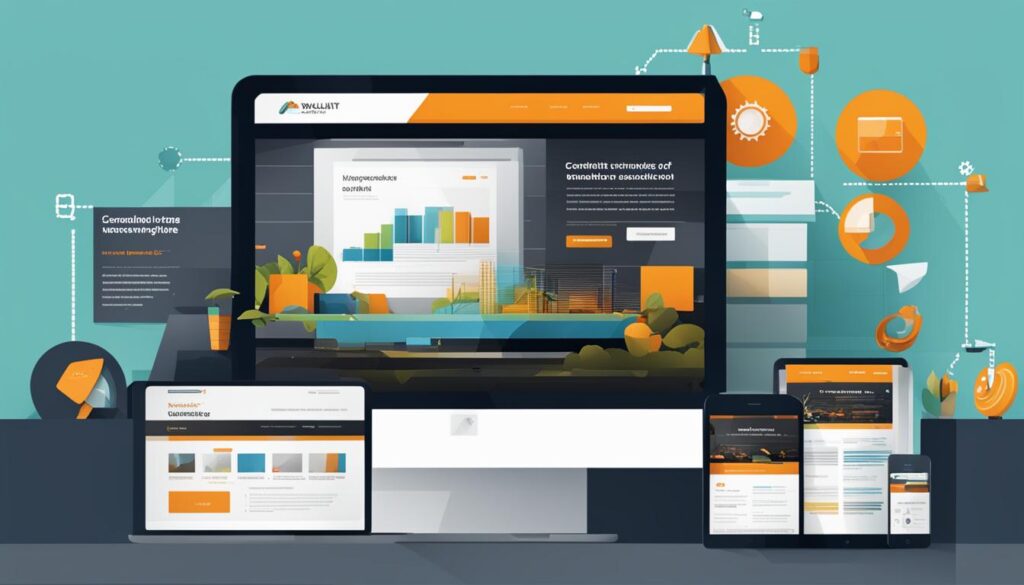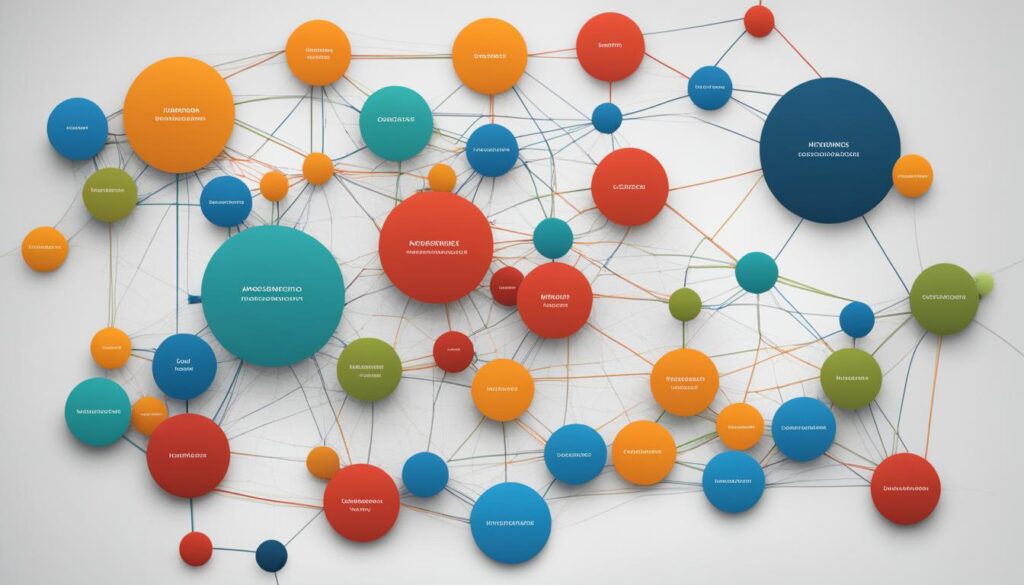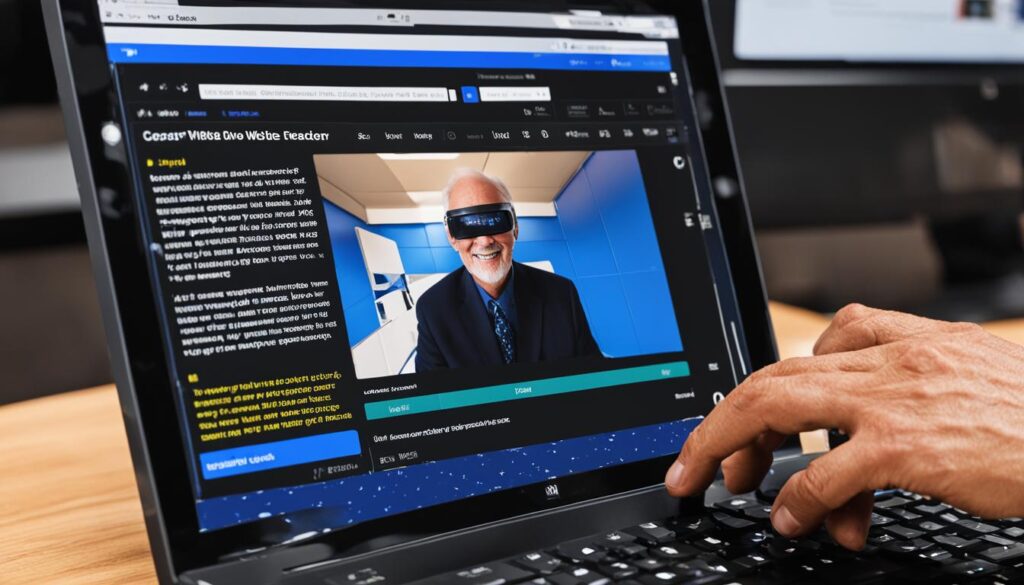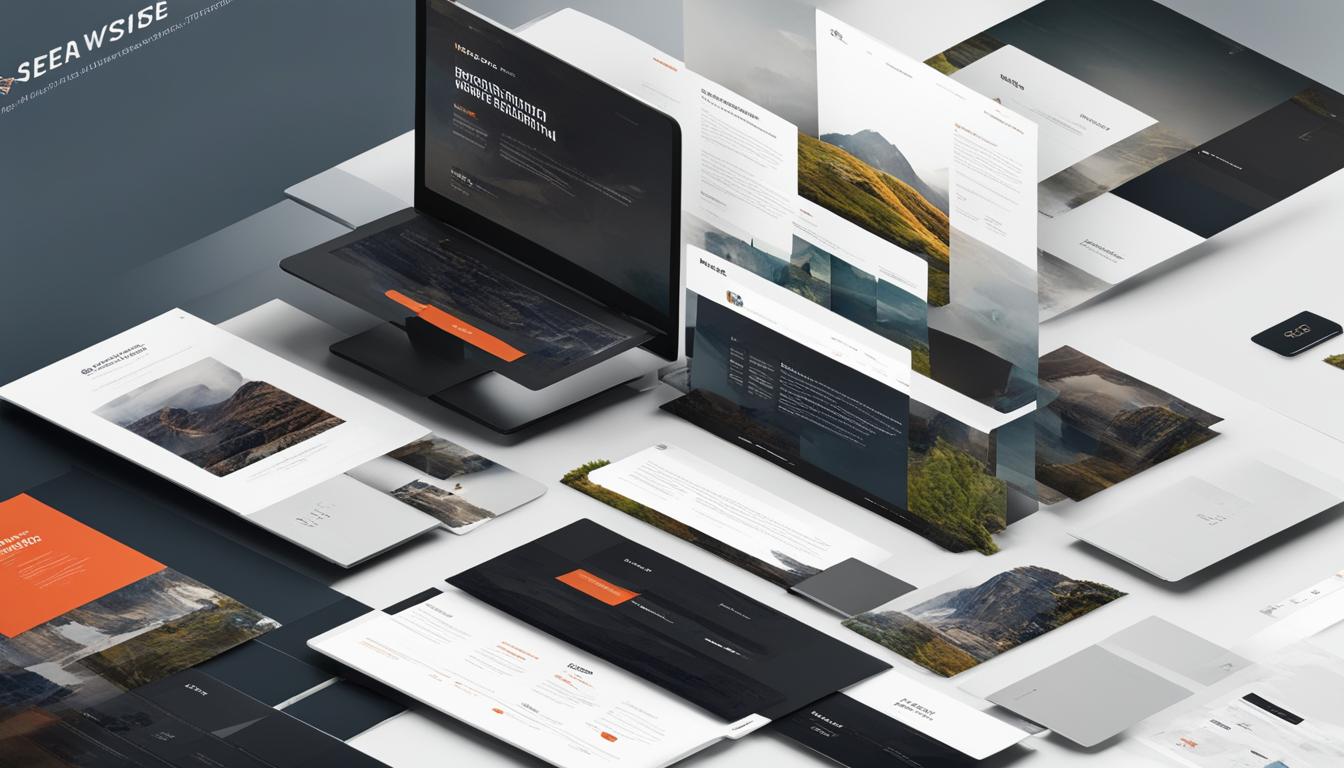A successful enterprise website is the nexus of your company, serving as a connection between your customers and your business. At WebsiteDesigner.Business, we understand the importance of creating a professional web design that is tailored to meet the specific needs of enterprises.
Our enterprise web design solutions are designed to help businesses establish a strong online presence and achieve their goals. Whether you need a website that showcases your products and services, enhances user experience, or drives conversions, our team of experienced designers will collaborate with you to create a cutting-edge web design that aligns with your business objectives.
With a focus on scalability, security, and user experience, our enterprise web design services ensure that your website can handle growth, maintain data security, and provide a seamless user journey. We adopt a user-centric approach to design, ensuring that your website is intuitive, easy to navigate, and visually appealing.
Partner with us for your enterprise web design needs, and let us help you unlock the full potential of your online presence.
Key Takeaways:
- Enterprise web design is crucial for establishing a strong online presence and connecting with your target audience.
- Scalability, security, and user experience are key pillars of successful enterprise web design.
- Adopting a user-centric approach helps create intuitive and engaging websites that drive conversions.
- Professional web design services can assist businesses in achieving their online goals and enhancing brand credibility.
- Partnering with a web development agency that specializes in enterprise web design can optimize your website for success.
The Importance of Scalability in Enterprise Web Design
In order to thrive in a competitive online landscape, enterprises must prioritize scalability in their web design strategy. A scalable website is essential for a growing business as it can handle increased traffic, user data, and content without compromising performance. It enables your website to grow organically alongside your business, adapting seamlessly to new needs and demands. Achieving scalability requires the integration of a robust content management system (CMS) and a dependable hosting solution to support steady growth and sudden popularity.
Scalability is the key to unlocking the full potential of your enterprise website. As your business expands, the ability of your website to accommodate increased traffic and handle additional data becomes critical. Without a scalable design, your website may experience lagging load times, crashes, and an overall poor user experience. These setbacks can result in lost revenue, decreased customer satisfaction, and damage to your brand reputation.
The Benefits of Scalability
A scalable website empowers your enterprise to:
- Seamlessly handle growth and increased website traffic
- Accommodate additional user data and content
- Maintain optimal performance and fast loading times
- Deliver a consistent and reliable user experience
By investing in enterprise-level website design that prioritizes scalability, you position your business for long-term success. A well-designed and scalable website can adapt to the evolving needs of your enterprise without requiring costly redesigns or complete overhauls. It offers the flexibility required to integrate new functionalities, expand product lines, and reach a broader audience.
Furthermore, scalability enables your website to handle peak traffic periods and sudden popularity without breaking under the pressure. Whether it’s a viral marketing campaign, a surge in seasonal sales, or a significant increase in online transactions, a scalable website ensures that your business operates smoothly and efficiently during times of high demand.
Ultimately, scalability is a critical component of an enterprise web design strategy. It empowers your business to grow, adapt, and succeed in an ever-changing digital landscape. By investing in scalability, you future-proof your website, provide users with an exceptional online experience, and position your enterprise for continued growth and prosperity.

| Key Points | Benefits |
|---|---|
| Accommodate increased traffic, user data, and content | Ensure optimal performance and fast loading times |
| Seamlessly integrate new functionalities and expand product lines | Handle peak traffic and sudden popularity without issues |
| Future-proof your website for growth and success | Deliver an exceptional online experience to users |
Ensuring Security and Compliance in Enterprise Web Design
A secure and compliant enterprise website is pivotal in building trust with customers and safeguarding valuable information. At [Company Name], we prioritize security and industry gold standards to deliver reliable solutions that protect your data and maintain compliance with regulations. Our corporate website design services are designed to enhance your online presence, while also providing peace of mind.
Designing with SOC 2 Compliance: SOC 2 compliance is a crucial component of secure enterprise web design. It encompasses security, availability, processing integrity, confidentiality, and privacy. By incorporating SOC 2 compliant security measures, we ensure that your website meets the highest industry standards for protecting sensitive data and maintaining the availability and integrity of services.
Enhancing Security Measures: In addition to SOC 2 compliance, we offer extra levels of security to safeguard your enterprise website. Our team implements features such as single sign-on and two-factor authentication to add an additional layer of protection, reducing the risk of unauthorized access.
Educating Teams on Best Practices: Security is a collective effort. We believe in empowering your team with the knowledge and tools necessary to maintain a secure environment. Through our corporate website design services, we provide comprehensive training on common scams, best practices, and the latest security protocols. By educating your team, we ensure that everyone remains vigilant and proactive in protecting valuable data.
At [Company Name], we understand the importance of compliant security in enterprise web design. Our expertise and dedication enable us to deliver secure and reliable solutions that meet industry standards and exceed client expectations.

| Benefits of Our Corporate Website Design Services | Features |
|---|---|
| Enhanced Security | SOC 2 compliance, single sign-on, two-factor authentication |
| Compliance with Regulations | Adherence to industry standards for data protection |
| Team Education | Training on common scams and best practices |
| Peace of Mind | Reliable security measures to protect your valuable data |
The Significance of Clear Information Architecture in Enterprise Web Design
Clear information architecture is a crucial aspect of successful enterprise web design. It plays a vital role in ensuring that your website is intuitive, user-friendly, and easy to navigate. By following a logical layout that aligns with user expectations and mental models, you can create a seamless browsing experience for your audience.
Designing the navigation, buttons, and forms based on users’ prior experience enhances their ability to find the information they need quickly and effortlessly. A well-organized website not only improves user satisfaction but also encourages engagement, ultimately driving conversions and achieving your business goals.
Implementing clear information architecture involves carefully categorizing and structuring the content on your website. This allows users to understand the hierarchy of information and easily locate the desired pages or resources. By providing a clear and intuitive path, you can guide users through your website, ensuring they find relevant content efficiently.
When designing the information architecture for your enterprise website, consider the following best practices:
- Perform thorough user research to understand their needs, preferences, and browsing behavior.
- Create user personas to guide the design process and tailor the website experience to different user segments.
- Use clear and descriptive labels for navigation menus, ensuring they accurately represent the content of the linked pages.
- Organize the content into logical sections and sub-sections, making it easy for users to navigate and comprehend.
- Include a search function that allows users to quickly find specific information within your website.
- Employ visual design elements such as consistent colors and typography to establish visual hierarchy and aid comprehension.
- Provide breadcrumb navigation to help users understand their current location within the website.
- Optimize page loading times to prevent user frustration and abandonment.
By prioritizing clear information architecture in your enterprise web design, you can create a user-centric experience that facilitates seamless navigation and efficient access to information. This not only enhances user satisfaction but also drives conversions and improves the overall performance of your website.
Benefit of Clear Information Architecture
A well-designed information architecture offers numerous benefits for both businesses and users:
| Benefits for Businesses | Benefits for Users |
|---|---|
| Improved Conversion Rates: Clear information architecture streamlines the user journey, making it easier for visitors to find what they need and complete desired actions, leading to higher conversion rates. | Efficient Navigation: Users can quickly locate the desired information and resources, minimizing search time and maximizing productivity. |
| Enhanced User Engagement: A well-organized website encourages users to explore more pages, increasing engagement and time spent on site. | Intuitive User Experience: Users can easily understand the structure and organization of the website, improving their overall experience. |
| Reduced Support Costs: Clear information architecture reduces the need for customer support as users can independently find the information they require. | Improved Satisfaction: Users’ increased ability to find information quickly and effortlessly leads to higher satisfaction levels. |
| Scalability: A well-designed information architecture allows for the seamless addition of new content and features as your enterprise grows. | Reduced Cognitive Load: Organized and easily accessible information reduces cognitive load and improves information processing. |

By implementing clear information architecture, you can create a website that not only meets the needs of your users but also contributes to the success of your enterprise.
Driving Conversions with Conversion-Focused Design in Enterprise Web Design
A conversion-focused design is essential for an enterprise website. Our goal is to attract, educate, and convert users into loyal customers. By implementing effective design changes and utilizing real-time marketing strategies, we can increase conversion rates and drive business growth.
Personalized experiences play a key role in capturing user attention and turning leads into customers. By understanding their needs and preferences, we can provide relevant content and offers that resonate with their interests. Real-time marketing allows us to adapt our messaging and promotions in response to user behavior, increasing the chances of conversion.
Site search functionality is another powerful tool in driving conversions. It enables users to quickly find what they’re looking for, improving their overall experience on the website. By implementing an intuitive and efficient search feature, we enhance user satisfaction and increase the likelihood of converting visitors into customers.
“A well-designed website can significantly impact conversion rates and drive business growth.”
Effective design changes can also have a significant impact on conversion rates. By analyzing website data and user behavior, we can identify areas of improvement and make strategic design tweaks. This could involve optimizing call-to-action buttons, improving form layouts, or enhancing visual elements to create a smoother user journey.
With real-time data and analytics, our marketing team is empowered to make data-driven decisions and implement tailored strategies. By constantly monitoring and optimizing performance, we can improve customer engagement and maximize conversions.
Conversion-Focused Design Strategies
Here are some key strategies we employ to drive conversions through design:
- Developing clear and compelling value propositions
- Implementing persuasive and visually appealing landing pages
- Optimizing user flows and minimizing friction points
- Utilizing effective storytelling techniques
- Creating intuitive navigation and user-friendly interfaces
By combining these strategies with an in-depth understanding of your target audience, we create an enterprise web design that captivates users, fosters trust, and ultimately drives conversions.
Conversion-Focused Design Case Study
To further illustrate the impact of conversion-focused design, let’s take a look at a case study:
| Metrics | Before Design Optimization | After Design Optimization |
|---|---|---|
| Conversion Rate | 3% | 7% |
| Time on Page | 1 minute | 4 minutes |
| Bounce Rate | 60% | 30% |
In this case study, implementing a conversion-focused design resulted in a significant increase in the conversion rate from 3% to 7%. The optimized design also increased the average time spent on the page from 1 minute to 4 minutes and reduced the bounce rate from 60% to 30%. These improvements demonstrate the positive impact of conversion-focused design on user engagement and conversion metrics.

Incorporating conversion-focused design principles into your enterprise web design is crucial for driving meaningful results. By prioritizing user needs, optimizing the user journey, and leveraging real-time marketing strategies, we can create a website that not only attracts visitors but also converts them into loyal customers.
Establishing a Unified Design System in Enterprise Web Design
A unified design system plays a pivotal role in the success of your enterprise website. It brings consistency and cohesiveness to your online presence, ensuring a seamless brand experience for your customers. At [Company Name], our expertise in custom web design for corporations and corporate web design services enables us to create a unified design system tailored to your unique needs.
So, what exactly is a unified design system? It encompasses internal guidelines, pre-built elements, and style guides that align with your brand identity. By establishing a unified design system, we ensure that every interaction, whether it’s a user interface element or a creative asset, adheres to your brand’s visual and experiential standards.
One of the key benefits of a unified design system is the ability to streamline the design and development process. With access to pre-built templates and components, we can create a consistent user experience across different sections of your website. This not only saves time but also allows for faster updates and improved scalability.
Creating a Consistent Brand Identity
A consistent brand identity is crucial for establishing trust and recognition among your target audience. With a unified design system, we ensure that your brand elements, such as logos, colors, typography, and imagery, are consistently applied throughout your website. This helps in creating a cohesive and memorable brand experience for your customers.
Let’s take a look at an example of how a unified design system can create a consistent brand identity:

Enhancing Collaboration and User Experience
Collaboration between different departments is essential for a successful enterprise website. By implementing a unified design system, we foster collaboration and ensure that everyone is on the same page. Designers, developers, and content creators can easily access the design system, align their efforts, and work towards a shared vision.
Moreover, a unified design system enhances the overall user experience. Consistency in design and interaction patterns across your website makes it easier for users to navigate and interact with your content. By eliminating confusion and providing a familiar interface, we create an intuitive user experience that keeps your visitors engaged.
Case Study: How [Company Name] Implemented a Unified Design System
“Working with [Company Name] was a game-changer for our corporate web design. Their team understood the importance of a unified design system and its impact on our brand identity. By implementing a robust system, they transformed our website into a visually cohesive platform that reflects our values and engages our customers.”
In conclusion, a unified design system is an integral part of enterprise web design. At [Company Name], we specialize in providing custom web design for corporations and corporate web design services that incorporate a unified design system. By aligning your brand, enhancing collaboration, and improving user experience, we will create a website that truly represents your business values and drives success.
| Benefits of a Unified Design System in Enterprise Web Design | Examples |
|---|---|
| Consistent brand identity | Same logo, colors, typography, and imagery used across the website. |
| Streamlined design and development process | Access to pre-built templates and components for faster updates and improved scalability. |
| Enhanced collaboration between departments | Designers, developers, and content creators aligned towards a shared vision. |
| Improved user experience | Consistency in design and interaction patterns for intuitive navigation and engagement. |
The Importance of Responsive Design in Enterprise Web Design
As we dive into the world of enterprise web design, it’s essential to understand the significance of responsive design. In today’s digital landscape, where the majority of internet users access websites through their mobile devices, a responsive design approach is no longer optional but necessary for success.
A responsive website is designed to adapt seamlessly to different screen sizes, ensuring optimal user experience across devices. Whether your customers are accessing your website on a desktop computer, smartphone, or tablet, it should remain accessible, functional, and visually appealing.
Responsive design doesn’t just involve adjusting the layout and appearance of your website; it goes beyond that. It also takes into consideration factors such as readability, navigation, and load time. By optimizing these elements, your website will provide a consistent and user-friendly experience, regardless of the device being used.
Moreover, responsive design plays a crucial role in search engine optimization (SEO). Search engines like Google prioritize mobile-friendly websites, as they enhance user experience and accessibility. By embracing responsive design, you not only cater to your audience but also improve your website’s visibility in search engine results.
“A responsive design approach ensures that your website remains accessible and functional, regardless of the device being used.”
So, how can you ensure a responsive design for your enterprise website? Here are a few key considerations:
- Use a mobile-first approach: Start designing your website with the mobile experience in mind and then scale up for larger screens.
- Optimize images: Compress and resize images to ensure fast loading times and proper display on different devices.
- Implement flexible layouts: Use CSS media queries to create fluid layouts that adapt to various screen sizes.
- Focus on typography: Choose fonts and font sizes that are legible on both desktop and mobile devices.
- Test across devices: Regularly test your website on different devices and browsers to ensure a consistent experience for all users.
By prioritizing responsive design in your enterprise web design strategy, you can effectively cater to the needs of your mobile-first audience, enhance user experience, and drive engagement. Remember, a responsive website is the key to staying relevant and competitive in today’s digital landscape.

Ensuring Accessibility in Enterprise Web Design
An accessible enterprise website is essential to ensure inclusivity for all users, including those with disabilities. By following web accessibility guidelines, you can create a website that caters to the diverse needs of your audience. Some key considerations for accessibility in enterprise web design include:
- Proper Color Contrast: Ensuring sufficient contrast between text and background colors helps users with visual impairments read and understand the content.
- Alternative Text for Images: Adding descriptive alt text to images allows screen readers to convey the meaning of the image to visually impaired users.
- Keyboard Navigability: Designing websites that can be easily navigated using only a keyboard is crucial for users who cannot use a mouse or other pointing devices.
- Assistive Technology Compatibility: Making your website compatible with assistive technologies, such as screen readers and voice recognition software, ensures that users with disabilities can fully access and interact with your content.
By prioritizing accessibility in enterprise web design, you not only improve the user experience for individuals with disabilities but also expand your audience reach. Additionally, demonstrating your commitment to inclusivity enhances your brand reputation and fosters a positive relationship with your audience.
“Ensuring accessibility in enterprise web design is not just a legal requirement; it is the right thing to do. By making our websites accessible, we are empowering individuals with disabilities to fully engage and participate in the digital world.”
At XYZ Web Design, we understand the importance of accessibility in enterprise web development. Our team of experts follows best practices and industry standards to create websites that are inclusive and accessible to all users.

| Platform | Color Contrast | Alternative Text | Keyboard Navigability | Assistive Technology Compatibility |
|---|---|---|---|---|
| Platform A | ✔️ | ✔️ | ✔️ | ✔️ |
| Platform B | ✔️ | ✔️ | ✔️ | ✔️ |
| Platform C | ✔️ | ✔️ | ✔️ | ✔️ |
As seen in the comparison above, leading enterprise web design platforms prioritize accessibility features, ensuring that your website meets the highest accessibility standards. At XYZ Web Design, we carefully select the right platform and customize it to meet your specific accessibility requirements.
When you partner with us for your enterprise web development needs, we guarantee an accessible website that caters to the diverse needs of your audience. Contact us today to discuss your project and take the first step towards a more inclusive online presence.
The Role of User-Centric Approach in Enterprise Web Design
A successful enterprise website is built on understanding and meeting the needs of your target audience. Adopting a user-centric approach ensures that every aspect of your website is designed with the user in mind. By prioritizing user experience, conducting thorough user research, and creating detailed personas, we can create an enterprise website that is intuitive and engaging.
When designing an enterprise website, it is essential to empathize with the end-users and understand their goals, pain points, and preferences. By uncovering these insights, we can make informed decisions that improve the overall user experience. This user-centric approach allows us to create a website that effectively communicates your brand message and drives customer satisfaction.
Understanding User Experience
User experience (UX) plays a pivotal role in enterprise web design. It encompasses the overall satisfaction and usability of your website. A positive user experience leads to increased engagement, higher conversion rates, and improved brand loyalty.
By conducting comprehensive user research, we gain valuable insights into user behavior, motivations, and expectations. This research allows us to identify pain points and uncover opportunities for improvement. We can then use these insights to inform our design decisions and create a user experience that surpasses user expectations.
Creating Personas for Targeted Design
Personas are fictional representations of your ideal audience segments. They help us visualize and understand the needs, goals, and preferences of different user types. By creating personas, we gain a deeper understanding of our target audience, allowing us to tailor the website design to their specific needs.
Each persona represents a unique set of characteristics, including demographics, motivations, and behaviors. By developing personas, we can make design decisions that resonate with each user group, creating a personalized and customized website experience for each segment.
“The user-centric approach in enterprise web design ensures that every decision we make aligns with the needs and preferences of our target audience. By empathizing with users and creating personas, we can build an intuitive and engaging website that effectively communicates our clients’ brand message.”
The Impact of User-Centric Design
A user-centric approach in enterprise web design has numerous benefits. It enables us to create an intuitive and engaging website that meets the specific needs of our target audience. By prioritizing user experience and leveraging user research, we can achieve the following:
- Increased user satisfaction and engagement
- Higher conversion rates and improved ROI
- Enhanced brand perception and credibility
- Greater customer loyalty and advocacy
- Deeper understanding of user needs and wants
By putting the user at the center of our design process, we ensure that every aspect of the enterprise website is optimized to meet their expectations. This user-centric approach sets the foundation for a successful online presence and drives business growth.
| Benefits of User-Centric Approach | Key Takeaways |
|---|---|
|
|
The Value of Cybersecurity in Enterprise Web Design
Cybersecurity is a major concern for enterprise websites. As technology evolves, the risk of unauthorized access, data breaches, and cyber attacks becomes more prevalent. Therefore, designing with robust security measures is crucial to protect sensitive data and maintain trust with customers.
Implementing cutting-edge hashing techniques, fraud detection algorithms, and blockchain solutions can minimize security risks and fortify your enterprise website. By staying one step ahead of potential threats, you can ensure the integrity and confidentiality of user information.
At (Your Company Name), we understand the significance of cybersecurity in enterprise web design. That is why we employ industry-leading practices and leverage advanced tools to safeguard your digital assets.
“Ensuring the security of our clients’ data is our top priority. We constantly update our security protocols to meet industry standards and mitigate potential risks.” – (Your Name), Chief Technology Officer
The Role of Automation in Cybersecurity
Automation plays a crucial role in enhancing cybersecurity for enterprise websites. By utilizing automated tools and processes, we can proactively detect and respond to security threats, significantly reducing the risk of potential breaches.
Automated threat analysis and incident response streamline the identification and resolution of security incidents, ensuring a rapid and efficient defense mechanism. This proactive approach allows us to detect and neutralize threats before they can cause significant damage to your enterprise web design.
Ensuring Compliance and Privacy
Compliance with regulations such as the General Data Protection Regulation (GDPR) and the California Consumer Privacy Act (CCPA) is essential for enterprise websites. Designing with privacy in mind, our team ensures that your website adheres to the necessary legal requirements to protect consumer data and maintain compliance.
By integrating comprehensive privacy measures and providing transparent data handling practices, we foster a safe online environment for your customers. Our commitment to compliance and privacy enables you to build trust and strengthen your reputation in the digital marketplace.
Empowering Your Enterprise with Cybersecurity
Investing in cybersecurity for your enterprise web design is an investment in the future success and sustainability of your business. It demonstrates your dedication to protecting customer data, maintaining trust, and staying ahead of evolving threats.
At (Your Company Name), we combine our expertise in enterprise web design with our comprehensive cybersecurity knowledge to create secure and resilient websites. Our team of cybersecurity professionals works diligently to ensure that your website remains shielded from potential threats.
Trust us to safeguard your enterprise web design, so you can focus on what matters most: growing your business and delighting your customers.
| Cybersecurity Measures | Benefits |
|---|---|
| Advanced encryption techniques | Protects sensitive data from unauthorized access |
| Regular vulnerability scanning | Identifies potential security weaknesses and allows for timely remediation |
| Secure coding practices | Minimizes vulnerabilities and ensures robust security |
| Real-time threat monitoring | Enables proactive defense against emerging cyber threats |
| User access controls and privileges | Restricts unauthorized access and ensures data privacy |

Effective Use of Low-Code Platforms in Enterprise Web Design
Low-code platforms have revolutionized the way enterprise web development services are approached. These platforms offer a streamlined approach, reducing the resources, time, and costs traditionally associated with building complex web applications. The low-code development environment allows non-technical users to create and customize web applications to meet specific business needs, empowering businesses to drive innovation.
With low-code platforms, the development process becomes more efficient and agile. Developers can quickly prototype, iterate, and deploy applications, accelerating the time-to-market. The visual, drag-and-drop interface of low-code platforms simplifies the development process, enabling users to build applications without the need for extensive coding knowledge. It empowers business users and citizen developers to actively participate in the app development process, reducing the reliance on IT teams.
By incorporating low-code platforms in enterprise web design, businesses can reap numerous benefits. These platforms offer:
- Rapid Application Development: Low-code platforms enable accelerated development, allowing businesses to respond quickly to market demands and changes in business requirements.
- Cost and Time Efficiency: With reduced coding efforts and faster development cycles, businesses can significantly cut down on development costs and time-to-market.
- Flexibility and Customization: Low-code platforms provide the flexibility to create tailored solutions, customized to specific business needs and processes.
- Scalability: The modular nature of low-code platforms enables easy scalability, allowing businesses to expand and adapt their applications as their needs evolve.
- User-friendly Interface: The intuitive user interface of low-code platforms makes it easier for business users to actively participate in the development process, resulting in faster iterations and enhanced collaboration.
Furthermore, low-code platforms offer built-in integrations with various enterprise systems, databases, and APIs, simplifying the integration and data exchange processes. This facilitates seamless connectivity and ensures the seamless flow of information across different systems and departments within the organization.
“Low-code platforms provide a powerful toolset for businesses to transform their ideas into functional web applications quickly and efficiently.”
Whether it’s building a customer portal, workflow automation tool, or an internal reporting dashboard, low-code platforms offer a flexible and scalable solution for a wide range of enterprise needs. From small businesses to large enterprises, the benefits of low-code platforms are evident across industries and sectors.
Incorporating low-code platforms into the enterprise web design ecosystem empowers businesses to drive innovation, streamline development processes, and stay competitive in the digital landscape.
See the table below for a comparison of popular low-code platforms:
| Platform | Key Features | Integration Capabilities | Scalability | Price |
|---|---|---|---|---|
| Mendix | Drag-and-drop interface, visual development, pre-built templates | Robust integrations with leading enterprise systems | Highly scalable with built-in cloud hosting options | Pricing varies based on the selected plan |
| OutSystems | Rapid development, UI customization, reusable components | Extensive API integrations, database connectors | Highly scalable with auto-scaling capabilities | Pricing available upon request |
| Power Apps | Low-code development, customizable templates | Seamless integration with Microsoft Office 365 and Azure | Scalability options based on selected plan | Pricing varies based on licensing options |
| Appian | Visual development, rapid prototyping, AI integration | Robust integrations with enterprise systems and APIs | Scalable with cloud-based hosting options | Pricing available upon request |
As the demand for efficient and agile enterprise web development services continues to grow, low-code platforms offer a compelling solution. By enabling non-technical users to actively participate in the web development process and accelerating development cycles, low-code platforms empower businesses to create innovative web applications tailored to their unique needs.

Conclusion
Building a successful enterprise website requires careful planning and consideration of various factors, including scalability, security, user experience, and design. By focusing on these pillars of enterprise web design, businesses can develop websites that drive growth, enhance brand credibility, and deliver exceptional user experiences.
However, creating an enterprise website that excels in all these areas can be a complex task. That’s why it’s crucial to partner with a professional web development agency that specializes in enterprise web design. These experts have the knowledge and experience to optimize your website for success.
At WebsiteDesigner.Business, we offer custom enterprise web design services to help businesses create websites that meet their unique needs. Our team of skilled designers and developers will work closely with you to understand your goals and requirements, and then craft a website that reflects your brand identity and delivers results.
Don’t leave the success of your enterprise website to chance. Visit WebsiteDesigner.Business today to order your enterprise web design plan and take the first step towards building a powerful online presence.
FAQ
What is the role of a successful enterprise website?
A successful enterprise website serves as the connection between your customers and your business, providing a scalable, secure, and user-friendly platform for interaction and engagement.
Why is scalability important in enterprise web design?
Scalability ensures that your website can handle the growth and increased traffic, user data, and content demands of a growing business, allowing for seamless expansion and adaptation.
How can security and compliance be ensured in enterprise web design?
By implementing industry gold standards like SOC 2 compliance, utilizing measures such as single sign-on and two-factor authentication, and educating your team on best practices, you can ensure the security and compliance of your enterprise website.
What is the significance of clear information architecture in enterprise web design?
Clear information architecture ensures that your website is intuitive and easy to navigate, enhancing user satisfaction and encouraging engagement by anticipating user expectations and mental models.
How can conversion-focused design drive success in enterprise web design?
Conversion-focused design attracts, educates, and converts users into loyal customers by leveraging real-time marketing, personalized experiences, effective site search, and design changes that drive conversions and improve customer engagement.
How does a unified design system contribute to enterprise web design?
A unified design system ensures consistency and cohesiveness across your website, streamlining design and development processes, facilitating collaboration, and enhancing the overall user experience.
Why is responsive design crucial in enterprise web design?
Responsive design ensures that your website can adapt to different screen sizes, maintain readability, and provide an optimal user experience, addressing the majority of internet users who access websites through mobile devices.
What is the importance of accessibility in enterprise web design?
Accessibility ensures that your website is inclusive of all users, including those with disabilities, by following web accessibility guidelines such as proper color contrast, alternative text for images, and keyboard navigability.
How does a user-centric approach impact enterprise web design?
A user-centric approach focuses on understanding and meeting the needs of your target audience, resulting in an intuitive and engaging website that effectively communicates your brand message and drives customer satisfaction.
How does cybersecurity contribute to successful enterprise web design?
Prioritizing cybersecurity in enterprise web design strengthens data protection and maintains trust with customers. Implementing robust security measures and automation tools minimizes security risks, ensuring the integrity and confidentiality of user information.
What is the value of low-code platforms in enterprise web design?
Low-code platforms offer a streamlined approach to enterprise web development, reducing resource, time, and cost requirements. They empower businesses to create web applications customized to meet specific business needs without extensive technical knowledge.
How can partnering with a professional web development agency optimize enterprise web design?
A professional web development agency has the expertise to create and optimize enterprise websites for success, leveraging their knowledge of industry best practices and cutting-edge technologies to deliver exceptional results.

Leave a Reply